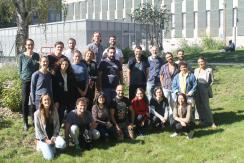COEVOL Multi-Scale Coevolution
Living systems are highly integrated, with a multitude of levels of organization, from molecular and intra-cellular scales to ecosystems. Complex organisms are themselves consortia of macro- and micro-organisms, which work together with their host to build the individual. Yet, each of these organisms can function and evolve in the short term according to its own logic, possibly in conflict with other higher or lower levels, or with other time scales. The once common idea among evolutionists that natural selection results in organisms perfectly adapted to their environment is now severely undermined. Not only because, as the Red Queen explains to Alice, one has to run relentlessly to keep its place in a changing environment, or because past evolutionary history and chance constrain the possibilities of present adaptation, but also because different levels of selection have interests that are generally difficult to reconcile.
Multi-scale coevolution resets classical questions in evolutionary biology
One example, of particular interest is the question of the source of heritable variations. The phenotype of organisms in a population is influenced not only by variations in their nuclear and mitochondrial genomes, the dynamics of which is the object of population genetics, but also more and more patently by the consortium of microbes and genetic elements that constitute its microbiome and virome. The hologenome designates this complex assembly of genetic materials, which obey different rules of transmission and different evolutionary strategies. The ability of symbionts to manipulate host phenotypes or to interfere with each other influences the evolutionary dynamics of all players in ways that are yet poorly understood. In addition, new questions arise, such as the importance of co-adaptation in these systems and their consequences in maintaining cohesive biological systems.
- Symbiosis: a response to and a source of divergent selection
Using a variety of approaches combining experimental evolution, genomic, functional, phenotypic and behavioral data, we aim to test whether symbiosis facilitates diversification and to characterize the underlying microevolutionary processes.
- Ecological networks of horizontal gene transfer
We develop original methods to detect gene transfer and we investigate the factors that influence the routes of gene transfers among microbes but also among insects.
- The interplay between symbiosis, infection and immunity and its evolutionary consequences
We try to understand the intimate interaction of hosts with pathogens, symbionts and transposable elements and how it affects the extended phenotype of the host.
- Transgenerational inheritance and environment changes
We try to decipher the molecular mechanisms that underlie rapid adaptation to environment and to test for transgenerational inheritance of fitness traits.
- Intragenomic conflicts and demography
We are developing models to test whether changes in the demography of the host affect the dynamics of transposable elements.
- The determinism of phenotypic convergence
We study the genomic basis of convergent phenotypic evolution in particular in the case of animals and plants adaptation to increasing temperature and decreasing water.
- Reconciling the tree of life
We develop phylogenetic methods for “reconciling” gene/species or host/symbiont histories and use these methods to explore the bulk of extinct or undescribed species and the history of association of symbiotic microbes with their hosts.
Integrating methods
The methods we use to tackle the questions raised by multi-scale co-evolution extend from theory, modelling and simulation to big data analysis, lab (notably on insects), and to a lesser extent, field activities.
Implication of research, responsibility of researchers and citizen sciences
From our research (some of which have immediate consequences in health, agriculture and ecology) and our concerns about the responsibility of scientists in society, we are committed to promote an “implicative” research. The implicative position means that we try to work on the link between science and society, not only through a one-way communication, applying or explaining our science, but also favoring early discussions on research projects, that may influence our research directions.
Publications
Display of 631 to 660 publications on 709 in total
Superparasitism acceptance and patch-leaving mechanisms in parasitoids: A comparison between two sympatric wasps
Animal Behaviour . 69 : 1227-1234
Journal article
see the publicationCost induced by viral particles manipulating superparasitism behaviour in the parasitoid Leptopilina boulardi
Parasitology . 131 : 161-168
Journal article
see the publicationÉvaluation des effets sublétaux d'insecticides sur des insectes auxiliaires entomophages
incollection . -- : 85-96
Journal article
see the publicationEfficient procedure for purification of obligate intracellular Wolbachia pipientis and representative amplification of its génome by multiple-pisplacement amplification
Applied and Environmental Microbiology . 71 ( 11 ) : 6910-6917
Journal article
see the publicationWolbachia requirement for oogenesis: occurrence within the genus Asobara (Hymenoptera Braconidae) and evidence for intraspecific variation in A. tabida
Heredity . -- : 267-282
Journal article
see the publicationA bunch of fun-guys: the whole-genome view of yeast evolution
Trends in Genetics . 21 : 1-3
Journal article
see the publicationExamining bacterial species under the specter of gene transfer and exchange
Proceedings of the National Academy of Sciences of the United States of America . 102 : 6595-6599
Journal article
see the publicationPerfect sorting by reversals
International Computing and Combinatorics Conference . 3595 : 42-51
DOI: 10.1007/11533719_7
Conference paper
see the publicationWhat transposable elements tell us about genome organization and evolution: the case of Drosophila
Cytogenetics and Genome Researchearch . 110 : 25-34
Journal article
see the publicationCytogenetic mechanism and genetic consequences of thelytoky in the wasp Trichogramma cacoeciae
Heredity . 93 : 592-596
Journal article
see the publicationVirulence multiple infections and regulation of symbiotic population in the Wolbachia-Asobara tabida symbiosis
Genetics . 168 : 181-189
Journal article
see the publicationPhylogenetic dating and characterization of gene duplications in vertebrates: the cartilaginous fish reference
Molecular Biology and Evolution . 21 : 580-586
Journal article
see the publicationPhylogenetic dating and characterization of gene duplications in vertebrates: the cartilaginous fish reference
Molecular Biology and Evolution . 21 ( 3 ) : 580-586
Journal article
see the publicationComment on "The origins of genome complexity
Science . 306 : 978a-978a
Journal article
see the publicationDetecting phylogenetic incongruence using BIONJ: an improvement of the ILD test
Molecular Phylogenetics and Evolution . 33 : 687-693
Journal article
see the publicationOn Metric Generators of Graphs
Mathematics of Operations Research . 29 : 383-393
Journal article
see the publicationTransposable element dynamics in two sibling species: Drosophila melanogaster and Drosophila simulans
Genetica . 120 : 115-123
Journal article
see the publicationDiversity distribution and specificity of WO phage infection in Wolbachia of four insect species
Insect Molecular Biology . 13 : 147-153
Journal article
see the publicationIntra-individual coexistence of a Wolbachia strain required for host oogenesis with two strains inducing cytoplasmic incompatibility in the wasp Asobara tabida
Evolution - International Journal of Organic Evolution . 58 : 2167-2174
Journal article
see the publicationComputational inference of scenarios for alpha-proteobacterial genome evolution
Proceedings of the National Academy of Sciences of the United States of America . 101 : 9722-9727
Journal article
see the publicationBacterial genomes as new gene homes: the genealogy of ORFans in E. coli
Genome Research . 14 : 1036-1042
Journal article
see the publicationStart-up entities in the origin of new genes
Current Opinion in Genetics and Development . 14 : 616-619
Journal article
see the publicationQuartet mapping and the extent of lateral transfer in bacterial genomes
Molecular Biology and Evolution . 21 : 86-89
Journal article
see the publicationSorting by reversals in subquadratic time
Annual Symposium on Combinatorial Pattern Matching (CPM) . 3109 : 1-13
Conference paper
see the publicationL`influence des éléments transposables sur la taille des génomes
Journal de la Société de Biologie . 198 : 413-417
Journal article
see the publicationVariation of the genome size estimate with environmental conditions in Drosophila melanogaster.
Cytometry Part A . 55 ( 1 ) : 43-9
DOI: 10.1002/cyto.a.10061
Journal article
see the publicationReduction in the sex ratio of the progeny of a parasitoid wasp (Trichogramma brassicae) surviving the insecticide chlorpyrifos
Archives of Environmental Contamination and Toxicology . 45 : 203-208
Journal article
see the publicationDivergent strategies in low temperature environment for the sibling species Drosophila melanogaster and D. simulans: Overwintering in extension border areas of France and comparison with African populations
Evolutionary Ecology . 17 : 523-548.
Journal article
see the publicationPhenotypic plasticity of sternopleural bristle number in temperate and tropical populations of Drosophila melanogaster
Genetical Research . 81 : 25-32
Journal article
see the publication

